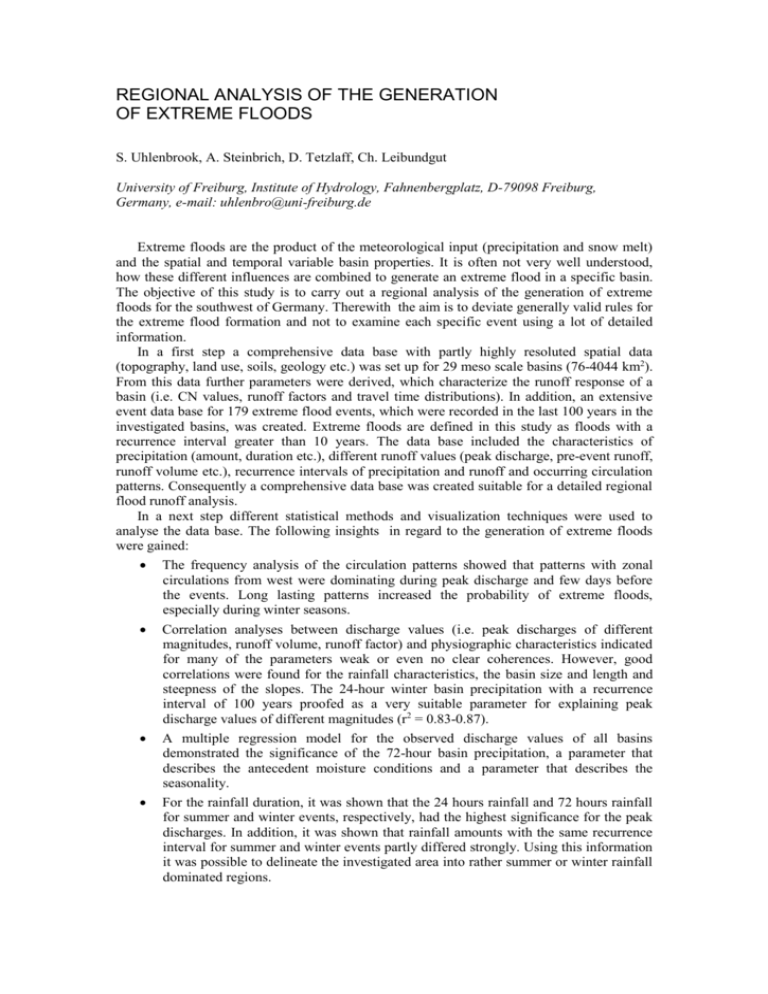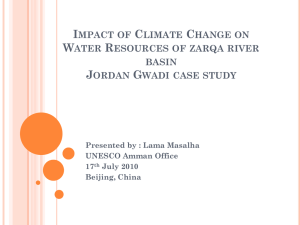Data bank for a regional analysis of extreme floods
advertisement

REGIONAL ANALYSIS OF THE GENERATION OF EXTREME FLOODS S. Uhlenbrook, A. Steinbrich, D. Tetzlaff, Ch. Leibundgut University of Freiburg, Institute of Hydrology, Fahnenbergplatz, D-79098 Freiburg, Germany, e-mail: uhlenbro@uni-freiburg.de Extreme floods are the product of the meteorological input (precipitation and snow melt) and the spatial and temporal variable basin properties. It is often not very well understood, how these different influences are combined to generate an extreme flood in a specific basin. The objective of this study is to carry out a regional analysis of the generation of extreme floods for the southwest of Germany. Therewith the aim is to deviate generally valid rules for the extreme flood formation and not to examine each specific event using a lot of detailed information. In a first step a comprehensive data base with partly highly resoluted spatial data (topography, land use, soils, geology etc.) was set up for 29 meso scale basins (76-4044 km2). From this data further parameters were derived, which characterize the runoff response of a basin (i.e. CN values, runoff factors and travel time distributions). In addition, an extensive event data base for 179 extreme flood events, which were recorded in the last 100 years in the investigated basins, was created. Extreme floods are defined in this study as floods with a recurrence interval greater than 10 years. The data base included the characteristics of precipitation (amount, duration etc.), different runoff values (peak discharge, pre-event runoff, runoff volume etc.), recurrence intervals of precipitation and runoff and occurring circulation patterns. Consequently a comprehensive data base was created suitable for a detailed regional flood runoff analysis. In a next step different statistical methods and visualization techniques were used to analyse the data base. The following insights in regard to the generation of extreme floods were gained: The frequency analysis of the circulation patterns showed that patterns with zonal circulations from west were dominating during peak discharge and few days before the events. Long lasting patterns increased the probability of extreme floods, especially during winter seasons. Correlation analyses between discharge values (i.e. peak discharges of different magnitudes, runoff volume, runoff factor) and physiographic characteristics indicated for many of the parameters weak or even no clear coherences. However, good correlations were found for the rainfall characteristics, the basin size and length and steepness of the slopes. The 24-hour winter basin precipitation with a recurrence interval of 100 years proofed as a very suitable parameter for explaining peak discharge values of different magnitudes (r2 = 0.83-0.87). A multiple regression model for the observed discharge values of all basins demonstrated the significance of the 72-hour basin precipitation, a parameter that describes the antecedent moisture conditions and a parameter that describes the seasonality. For the rainfall duration, it was shown that the 24 hours rainfall and 72 hours rainfall for summer and winter events, respectively, had the highest significance for the peak discharges. In addition, it was shown that rainfall amounts with the same recurrence interval for summer and winter events partly differed strongly. Using this information it was possible to delineate the investigated area into rather summer or winter rainfall dominated regions. Using a cluster analysis a spatial delineation into six regions with similar temporal flood runoff behavior was possible. The regions are within geographical proximity (without considering the spatial position into the analysis). The long term mean monthly highest discharge values and the long term mean monthly highest precipitation values were examined. An oppositional seasonal behavior was shown for both variables. In addition, systematic regional variations were observed for the whole test site. On the one hand, possibilities and limitations of deviating general conclusions about the formation of extreme floods are highlighted. Every single flood in a specific basin is an individual, resulting from a particular combination of different influences, i.e. precipitation, antecedent wetness and several spatial and temporal variable basin properties. On the other hand, the results show some clear coherences for the generation of extreme floods. These findings should be considered for several practical applications, for instance the regionalization or the prediction of discharge values, or an improved river basin management.











